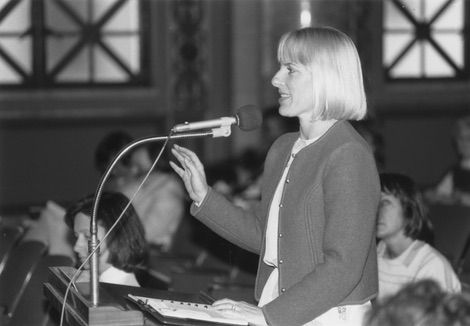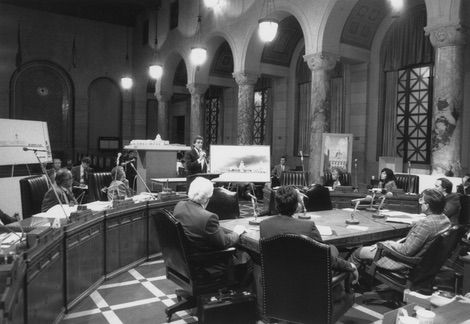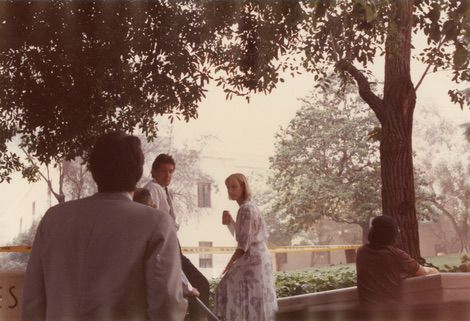This post is the fifteenth in a series of excerpts serializing the book Feels Like Home.
Chapter 7
Los Angeles Central Library Project – The Short Version - part 1 by Betty Gay Teoman, Central Library Director 1984-1998
Christina Rice’s request to write an essay about my experiences with the Central Library generated a swirl of memories. They are mostly about people at the library and those who helped us during the more than ten-year planning process to produce the rehabilitated and expanded Central Library which opened on October 3, 1993.
Working at Central - Working on the Los Angeles Central Library project was the adventure of a lifetime for everyone involved. And, if you worked at 630 West Fifth Street in architect Bertram Goodhue’s 1929 building in the 1970s and 80s, you were involved.

It had all the proper aspects of an adventure story: the lows of working in the shabby, crowded, unairconditioned Central Library; dreadful lows of the 1986 arson fires; highs of the post-Fire community support for the library and the new Library Foundation; and the incredible highs of the two exuberant Opening Days; May 22, 1989, temporary Spring Street Library and October 3, 1993, Rehabilitated and Expanded Central Library. That last title is quite a mouthful, and we used it consistently to describe the project during the planning process.
It was often exhausting, discouraging, depressing, even frightening. These feelings were offset by the incredible grace, commitment, and creativity of the people we worked with to revive this hugely important Los Angeles landmark—the Central Library and its historic building. And, blessedly, almost everyone involved somehow found a way to bring a sense of humor to lighten the enormous task. The regular children’s puppet shows for staff who remained working on book inventory in the fire-damaged building immediately come to mind.
My close connection with Central Library started in May 1976, when I became Subject Department Manager for the Science, Technology & Patents Department. Living Downtown and walking to work, I eagerly became part of the cadre of strongly committed people working in every nook and cranny of that remarkable building. The Goodhue building may have been on the National Register of Historic Places, but it was overcrowded with people and books, shabby, poorly maintained, with limited automation (possibly one computer per public reference desk), and with an outstanding collection of library materials packed tightly into stacks everyone involved agreed had been a firetrap since the day it was built. It was the public Central Library, administrative headquarters for the entire library system, and home for technical services for the system’s books (let’s use the generic term for everything we bought) and automation. Except for ARCO Towers and the California Club, the neighborhood was also shabby and the library’s West Lawn Park had long since been replaced by a parking lot.
Building Planning - City Librarians, Library Boards, and City Officials had been looking for solutions to the building’s appalling conditions for years. These efforts focused on a new, much larger library. Whenever a prospect came along, Administrative Staff and anyone they could commandeer worked to explore and support the project. Soon after my arrival, I helped with the library’s discussions with developer Charles Luckman and with architects Welton Beckett & Assoc. One proposal would replace Central Library with another, larger building on the same site. Another offered to build a new retail development in another Downtown location, including a new library on that site. The Luckman plan generated enough community opposition to result in the 1978 founding of the Los Angeles Conservancy.
All this intense effort stopped cold when the 1978 passage of Proposition 13 made it clear the City had to confront other financial issues. It did not expect to have funds to build libraries for some considerable time. This was a very low period for the library which saw funding and staff cuts systemwide.
Gradually, behind-the-scenes discussions about Central Library resumed. City leaders, ARCO’s CEO Lod Cook and developer Rob Maguire, saw the library as an important City asset right where it was. They had strong support from the Community Redevelopment Agency (CRA) Director Ed Helfeld and the CRA Board. In October 1982, the CRA formally presented a City Council Committee with its proposal to fund Central Library’s rehabilitation and expansion. Months later, on April 26, 1983, the City Council approved CRA’s Financing Concept and Schedule.
Central Library now had a powerful advocate responsible for carrying the project forward. CRA knew the City planning process very well, but its staff usually reviewed developers’ plans and did not manage City projects of this scope. The Library Board and Administration still preferred a new library building and were skeptical of this approach. But now CRA had the money and the assignment. Central Library Director Loyce Pleasants strongly supported adding Library Project Liaison to my Assistant Central Library Director duties. It became my job to help expedite the CRA’s new library project and report regularly to Administrative staff to make sure all the library’s interests were addressed and protected.
The CRA plan included funding for a new systemwide automation system and a library building consultant to develop the detailed building program for the architects. The library had solid information about the size of the current collection and staff but wanted professional guidance to plan for future needs. CRA would pay the bill, but City Librarian Wyman Jones would manage the consultant’s Building Program effort. They couldn’t agree to select a single candidate, so they combined two consulting firms into a team. Staff from throughout the library helped develop the Building Program which consultants Becker & Hayes, Robert H. Rohlf, and the Omni Group published on April 30, 1984.
The Library and CRA easily agreed to hire New York architects Hardy Holzman Pfeiffer Associates (HHPA), a firm with great credentials for successful work with historic buildings. In June 1983, CRA hired HHPA to assess the Goodhue building and produce Concept Drawings for the library. This was way ahead of having a detailed Building Program, but HHPA was looking at possible alternatives to expand the building and its services—details could follow.


These Concept Drawings were reviewed with the project’s stakeholders to get their support. Among them were the Central Library Task Force of City Department Heads, Cultural Affairs Commission, Cultural Heritage Commission, AIA, Los Angeles Conservancy, California State Historic Preservation Office, CRA Board, Board of Library Commissioners, City Council staff and Committees, and the full City Council. Mayor Tom Bradley was enthusiastic and strongly supportive. City Administrative Officer (CAO) Keith Comrie and his staff played a key role in the planning. Reviews by these and other agencies occurred at every stage along the way until final building plans were approved for bidding in October 1989. As the liaison, and later the Library’s project manager, I was in almost daily contact with staff at the CAO, City Attorney and CRA.
On August 20, 1985, City Council approved the project’s EIR and all the appropriate legal documents to finalize the City’s commitment to the project. HHPA was contracted for the next phase of the project design and the Central Library project was absolutely moving forward. Library Board and staff began planning to move all services in the building to temporary quarters during construction. The schedule gave us more than 18 months to find them and make them ready for move-in.
Fire - On April 29, 1986, arson fire closed Central Library. That Tuesday morning, architect Norman Pfeiffer was in my 3rd Floor office reviewing plans for the 1st and 2nd Floors of the Goodhue Building. At 10:53 a.m., when the fire alarm rang, I told him false alarms happen often and we walked downstairs together, leaving everything there. It was late in the day, after 6 p.m., before we were able to return to check the condition of the building—and get Norman’s briefcase and rental car keys.
As usual with alarms, I stayed in the 1st Floor lobby until we evacuated the public from the building. When it became clear there really was a fire, I called the CAO’s office from the Security Desk phone to notify them and then left. For a while, Norman and I stayed near the Fire Department command center to answer any questions they had about the building. The stacks were confusing under the best circumstances and now they were filled with smoke, flames, and water. It was a very long day. I later learned from the Fire Department staff that they nearly lost the building. Being able to break through the roof to put water on the burning closed stacks finally worked.

Next Week: Central Library Rebuilds.
Betty Gay Teoman began her career at the Los Angeles Public Library in 1969 and held a variety of positions throughout the system before coming to Central Library in 1984. From 1983 until the October 3, 1993 re-opening of the rehabilitated and expanded Central Library, she also served as the Library’s Liaison and Project Manager, working with Hardy Holzman Pfeiffer Architects and City and Community Redevelopment Agency staff to complete the building’s planning, design, financing, and construction. It was a creative, successful public-private partnership. Due to the 1986 arson fires which struck the building, this work included assisting with disaster recovery efforts. In 1998, she retired from the Los Angeles Public Library after a 30-year career, later lending her expertise to the Rye Free Reading Room in Rye New York and the Rancho Mirage Public Library. Currently retired, she resides with her husband Kory in Rancho Mirage.
Feels Like Home: Reflections on Central Library: Photographs From the Collection of Los Angeles Public Library (2018) is a tribute to Central Library and follows the history from its origins as a mere idea to its phoenix-like reopening in 1993. Published by Photo Friends of the Los Angeles Public Library, it features both researched historical accounts and first-person remembrances. The book was edited by Christina Rice, Senior Librarian of the LAPL Photo Collection, and Literature Librarians Sheryn Morris and James Sherman.The book can be purchased through the Library Foundation of Los Angeles Bookstore.
